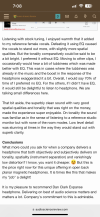DavidMcRoy
Addicted to Fun and Learning
- Joined
- Jul 10, 2018
- Messages
- 576
- Likes
- 997
I completely agree. The way we hear things is often at odds with how we "listen." I probably pay a lot more attention to noise, distortion and coloration than the average listener in preference tests because I'm a veteran audio engineer. I'm afraid for me, trial and error and either returning product or EQing it will suffice. So, if I find others who seem to have similar perceptions to my own, their individual advice is probably more useful to me than the results of man-on-the-street mass testing concensus. To reiterate, I don't personally care what the mass market preference tests show. If those curves sell more product, fine...but it's not for me. When advised that my preference is at odds with what most people prefer, I say "so what?"I think it's a win for the community that many get a chance to try a popular tuning and weigh in how much or little it matches their preference. Despite objective benchmarks (multiple ones) there's still a place for discussing subjective impressions, indeed amirm does give his at the end of every review.
"Stop trying to interior decorate me out of my music."
- Joni Mitchell to record label execs in the 1980s
Last edited:

